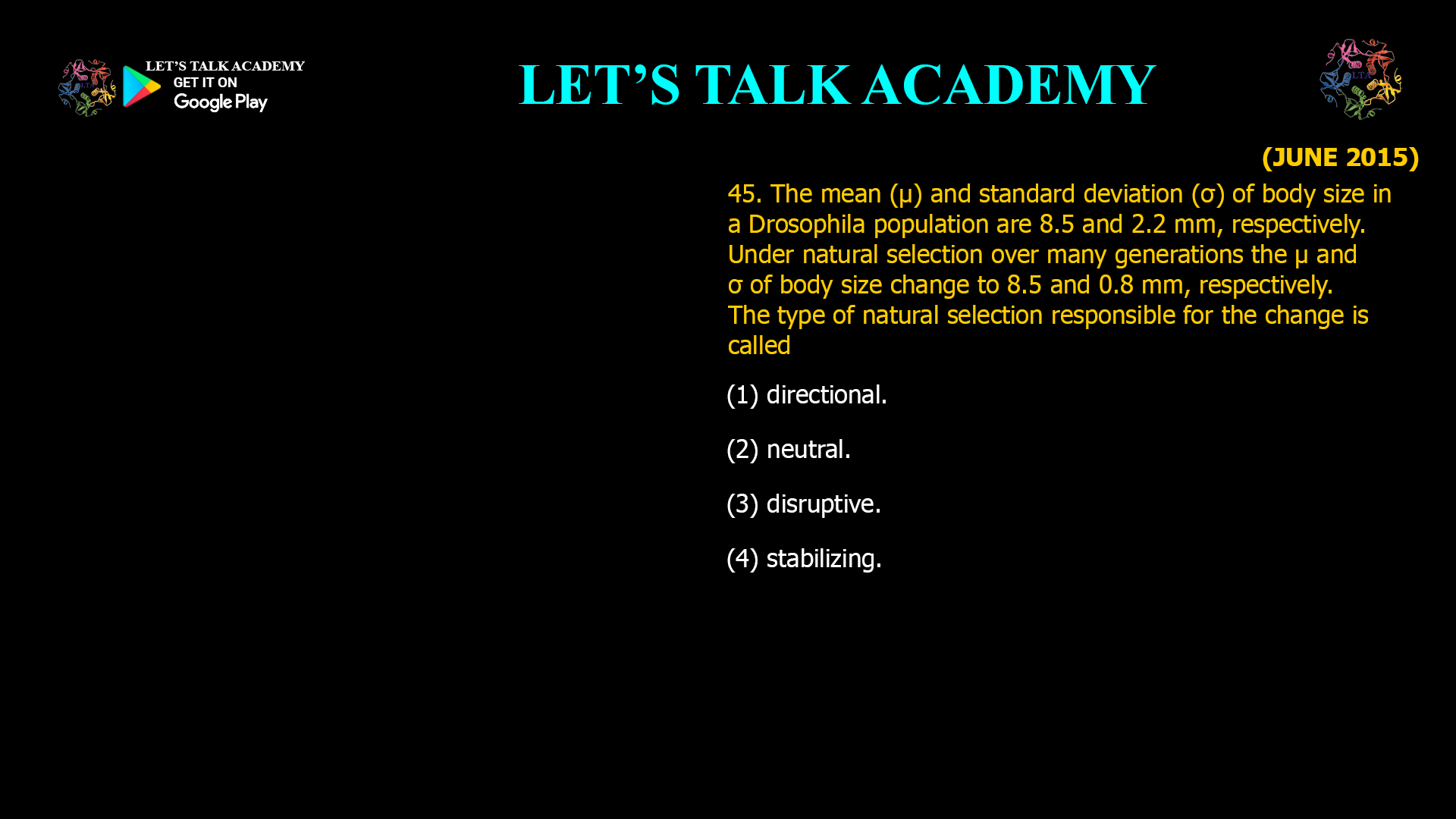- The mean (µ) and standard deviation (σ) of body size in a Drosophila population are 8.5 and 2.2 mm, respectively. Under natural selection over many generations the µ and σ of body size change to 8.5 and 0.8 mm, respectively. The type of natural selection responsible for the change is called
(1) directional. (2) neutral.
(3) disruptive. (4) stabilizing.
Introduction
Natural selection shapes the traits of populations over generations, influencing not just the average characteristics but also the variation within populations. In a population of Drosophila (fruit flies), when the mean body size remains constant but the variation decreases significantly, this pattern points to a specific type of natural selection known as stabilizing selection.
Case Study: Body Size in Drosophila
Consider a Drosophila population where the initial mean (µ) body size is 8.5 mm with a standard deviation (σ) of 2.2 mm. After many generations under natural selection, the mean remains at 8.5 mm, but the standard deviation decreases to 0.8 mm. This means the average size hasn’t changed, but the population now has less variation in body size.
What Does This Change Indicate?
-
Constant Mean (µ): The average trait value remains stable.
-
Reduced Standard Deviation (σ): The spread or variability of the trait decreases.
This pattern is characteristic of stabilizing selection, where individuals with intermediate traits are favored, and those with extreme traits (either smaller or larger body size) are selected against.
What Is Stabilizing Selection?
Stabilizing selection is a form of natural selection that favors the average phenotype and reduces the frequency of extreme phenotypes. It acts to maintain the status quo in a population by eliminating individuals with traits that deviate too far from the mean.
Key Features
-
Favors Intermediate Traits: Individuals close to the mean have higher fitness.
-
Reduces Variation: Extreme phenotypes are less likely to survive and reproduce.
-
Maintains Population Stability: The population remains well-adapted to its environment.
Why Does Stabilizing Selection Occur?
In many stable environments, extreme traits can be disadvantageous. For example, in Drosophila, very small body size might reduce survival or reproductive success, while very large size might be energetically costly or make flies more vulnerable to predators. Thus, natural selection favors individuals with moderate body sizes.
Comparison with Other Types of Selection
| Type of Selection | Effect on Mean (µ) | Effect on Variation (σ) | Example Scenario |
|---|---|---|---|
| Stabilizing Selection | Mean remains constant | Variation decreases | Body size in Drosophila |
| Directional Selection | Mean shifts toward one extreme | Variation may increase or decrease | Evolution of antibiotic resistance |
| Disruptive Selection | Mean may remain constant | Variation increases | Beak size in Darwin’s finches with bimodal seed sizes |
| Neutral Selection | No effect on mean or variation | No effect | Genetic drift in neutral alleles |
Evolutionary Significance
Stabilizing selection helps maintain traits that are well-suited to the environment, preventing populations from drifting toward less advantageous extremes. It is considered one of the most common forms of natural selection in nature.
Conclusion
The observed decrease in variation of Drosophila body size, while maintaining the same mean, is a clear example of stabilizing selection. This type of natural selection plays a crucial role in preserving optimal traits and maintaining population stability over time.
Correct answer:
(4) stabilizing
SEO-Friendly Slugs:
-
stabilizing-selection-drosophila-body-size-evolution
-
natural-selection-types-stabilizing-explained
-
how-stabilizing-selection-reduces-trait-variation
-
evolutionary-effects-stabilizing-selection
-
drosophila-body-size-selection-study
Stabilizing selection highlights nature’s preference for balance, favoring individuals with average traits and ensuring populations remain adapted to their environments.



